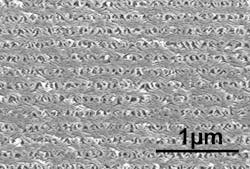Chemically resistant porous multilayer silicon carbide spectral optics could have biosensing uses
| 70-nm-thick porous layers in silicon carbide: individual layers are clearly visible. (Image: TU Wien) |
Extremely fine porous structures can be generated in semiconductors, opening up new possibilities for novel sensors, optics, and electronics; experiments in this area have already been done in silicon. Now, researchers at TU Wien (Austria) have come up with a way to fabricate porous silicon carbide (SiC) in a controlled manner.1SiC has some advantages over silicon; for example, its greater chemical resistance allows it to be used for biological applications, for example, without any additional coating required.
To demonstrate the potential of this new technology, a multilayer optical mirror that selectively reflects and transmits different colors of light was integrated into a SiC wafer by creating layers with a thickness of approximately 70 nm each and with different degrees of porosity, and thus with differing refractive indices.
This could be very useful in sensor technology: for example, the refractive index of minute quantities of liquid could be measured using a porous semiconductor sensor, allowing a reliable distinction between different liquids.
Another attractive option from a technical and application-oriented perspective is to first make certain areas of the SiC wafer porous in a highly localized manner, before depositing a new SiC layer over these porous areas, and then causing the latter to collapse in a controlled manner – this technique produces microstructures and nanostructures which can also play a key role in sensor technology.
"Until now, silicon has been used for this purpose, a material with which we already have a lot of experience," says Ulrich Schmid, one of the researchers. However, under harsh environmental conditions, for example in extreme heat or in alkaline solutions, structures made of silicon are attacked and rapidly destroyed.
Creating the color-selective mirror
The surface was cleaned, then partially covered with a thin layer of platinum. The SiC was then immersed in an etch solution and exposed to UV light to initiate oxidation, causing a thin porous layer -- initially 1 µm thick -- to form in the areas that were not coated with platinum. An electrical charge was also applied to precisely set the porosity and the thickness of the subsequent layers. Here, the first porous layer promoted the formation of the first pores when the electrical charge was applied.
"The porous structure spreads from the surface further and further into the interior of the material," explains Markus Leitgeb, another researcher. "By adjusting the electrical charge during this process, we can control what porosity we want to have at a given depth."
Finally, the resulting complex layered structure of SiC layers with higher and lower levels of porosity was separated from the bulk material by applying a high-voltage pulse. The thicknesses of the individual layers were selected so that the layered structure became a integrated, color-selective mirror/filter.
Source: https://www.tuwien.ac.at/en/news/news_detail/article/125552/
REFERENCE:
1. Markus Leitgeb et al., APL Materials 5, 106106 (2017); https://doi.org/10.1063/1.5001876
